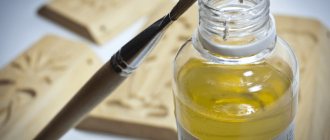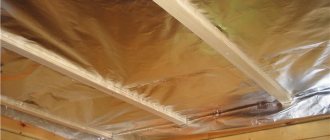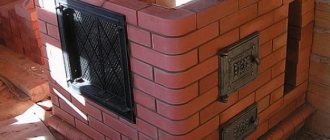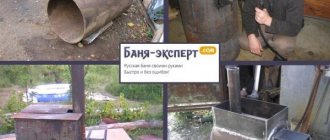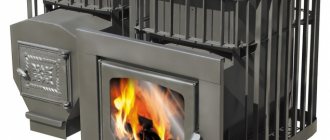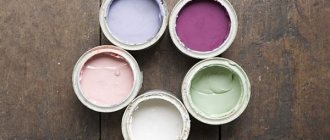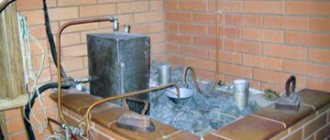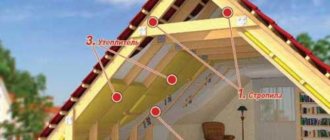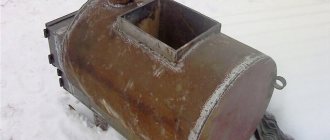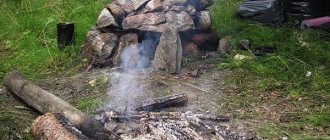Painting an iron stove
High temperature, excess humidity, cycles of alternating heating and cooling, all this affects the metal structure - actively destroying its surface. It is clear that paint and varnish materials must withstand all this without losing their physical properties, maintaining an aesthetic appearance and protecting the metal from corrosion.
What kind of paint
Heat resistant paint
Heat-resistant silicone enamel is well suited. Its abbreviation begins with the letters “KU”. Next come the numbers. There are brands that remain resistant to temperatures of six hundred to seven hundred degrees. In addition, heat-resistant silicone enamel reliably tolerates moisture, steam and cycles of sudden heating and cooling. In addition, the influence of high temperatures improves the adhesion index to the substrate.
There are also special fire-resistant paints. However, their purpose is to protect or maximize the time before the surface ignites. Therefore, such paints are not designed to create a particularly aesthetic appearance. They are certainly effective, but the price...
The “favorite” color covering most stoves is black or close to it. This is due (and not without reason) to the fact that such a color scheme provides better heat transfer. Well, maybe someone remembers the term “absolutely dark body” (this does not apply to people from the African continent). Therefore, most heat-resistant paints are dark in color. By the way, there are enamels that can be applied at negative temperatures. This expands the usability.
“For information: the temperature inside the firebox of an average sauna stove does not exceed 800°.”
Thermal spray paint
Preparatory stage: If there are traces of dust or dirt on the surface, remove. Wash off with soapy water, scrub, etc. After that, degrease the surface. Acetone and white spirit are suitable for this. If there is rust or scale, carefully brush it with an iron brush, sand it and treat it with a solvent.
“If the stove is new, “freshly cooked” - heat it. This will allow you to “burn out” the remaining fats, grease and other debris accumulated in the pores and microshells, from where it is problematic to get them out with an ordinary rag.”
How to paint
The paint is applied in 2-3 approaches. Try to make a thin layer, this will prevent the formation of smudges. Before proceeding to the next layer, test for tack. Complete drying of the paint occurs during the first firing of the furnace, and at 150-200° its polymerization begins, or, more simply, sintering. After which, it gains its maximum strength.
Preparatory stage: If there are minor defects (depressions, bumps, potholes), first plaster and level, and cover the seams with a clay solution. You can learn how to prepare a good clay solution from the corresponding article, which is on the blog...
Plaster is made from clay and crushed asbestos. The resulting mixture is carefully applied to a well-heated stove.
How to paint: The two most popular proven folk methods are lime or chalk. The third method is again heat-resistant paint, which is also used for iron sauna stoves.
- Pour the pieces of chalk into a container (bucket, basin), fill with slightly warm water so as to cover the surface and leave for at least one hour;
- In another container, mix animal glue with warm water in a ratio of 25:1. Animal glues include gelatin, casein, albumin, and bone.
- Mix both solutions and bring to a homogeneous consistency. “To check the quality of the solution, drop it on a piece of glass or mirror placed vertically. If the density is normal, then the droplet will slide down by 2-3 cm.”
- Apply two or three layers. Each subsequent one, only after the previous one has dried. “For a more “clean” whiteness, you can add a tablespoon of blue to a bucket of the finished solution. It will remove some of the yellowness.”
- Solution proportions: 1 kg of lime / 1.5 liters of water at room temperature / 1 tbsp. spoon of drying oil / 25-30 grams of blue / 1 tbsp. spoon of salt. Mix. “The most durable whitewash is made from freshly slaked lime, and salt is added to make the lime coating less dirty.”
- Apply in two or three layers. Unlike whitewashing with chalk, each subsequent layer of lime whitewash is applied to the wet previous one. “If the stove in the bathhouse was previously painted with chalk, and you intend to use lime (and vice versa), the surface must be thoroughly cleaned of old paint.”
Video description
How to quickly and easily paint a stove with Cetra brand products, watch in this video:
Among foreign brands, the most popular are:
- Finnish Tikkurilla;
- English Hammerite and Bosnia;
- Lithuanian Hansa.
Enamels Kudo, Elkon, Cetra, Hansa, Bosni are produced not only in the usual liquid form, but also in aerosol cans. When choosing what to paint a stove in a bathhouse with, if it has a complex structure or is installed in an inconvenient place for painting, it is best to choose aerosol paints. Or use a compressor with a spray gun.
Note! There are suitable compositions on the market for metal structures from other manufacturers. Heat-resistant silicone enamels are marked KO followed by a series of numbers, the first of which should be 8.
Such compositions can withstand temperatures up to 800 degrees and above Source begeton.com
Why apply paint?
The main disadvantage of metal is that when exposed to moisture for a long time, it begins to rust, gradually deteriorating. This process proceeds faster if the material is subjected to constant heating.
We invite you to familiarize yourself with Iron for a boiler in a bathhouse
The purpose of the paint composition is to protect metal surfaces from rust and overheating. Sheets of metal look ugly compared to the exterior decoration of bathhouses. Enamel can be used to improve the appearance of equipment.
After selecting the coloring composition, you can begin work. To do this, you need to collect tools, prepare a metal surface, and perform actions following the technology.
Before painting work, you need to prepare consumables and tools:
- solvent for degreasing metal surfaces;
- metal cleaning brush;
- sandpaper
- coloring composition - it is better to choose products in aerosol cans;
- a grinder for cleaning large metal sheets;
- rags;
- roller, brush, if the paint is spilled into cans;
- plastic film to cover other surfaces.
If you need to paint a large area, you can use a spray gun with a compressor.
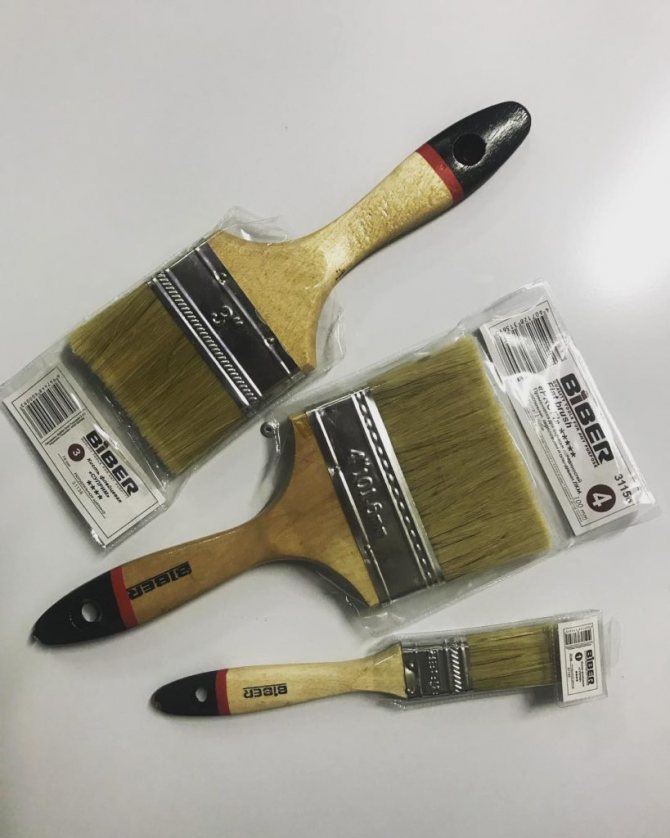
Paint brushes
Do not apply enamel to an unprepared surface. Before this you need to perform several steps:
- Use a brush to clean the metal from dirt and deposits;
- You can remove scratches, bumps, and rust using fine sandpaper;
- sweep away any dust with a broom;
- moisten a rag in solvent and degrease metal surfaces.
After completing the preparation, you need to cover the walls, floor and ceiling adjacent to the stove with plastic wrap.
When the paint has been purchased and the metal preparation has been completed, the main work can begin. Painting stages:
- Open the paint and stir thoroughly using a wooden or plastic stick. If the coloring composition is too thick, it can be diluted with a solvent. The packaging indicates a substance that can be used to dilute the paint. If you do not take this information into account, you can ruin the paint composition.
- Using a brush, paint over awkward places and go along the edges. After this, paint over the main surfaces with a roller. It is important to control the uniformity of the layer application and not leave any empty spaces.
After applying the paint, you need to close all rooms and windows. For some paints and varnishes, you need to heat the oven, since they only harden when heated.
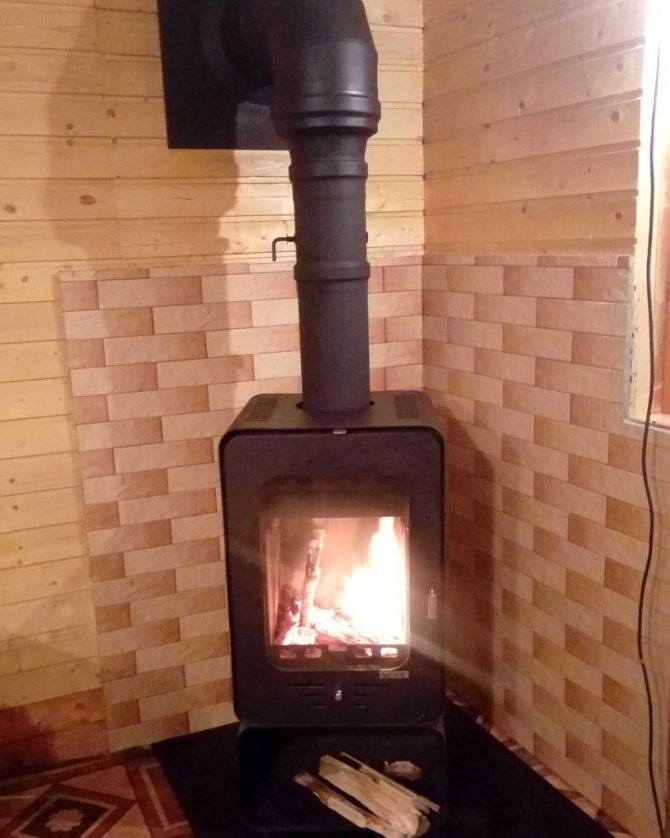
Kindling the stove
Many people do not know how long to wait until the protective coating is completely dry. This parameter depends on the type of paint. Information about complete drying is indicated by the manufacturer on the packaging of the paint and varnish composition. The average period of time required for the decorative layer to completely harden is 72–96 hours. If you heat the oven before this time period has expired, exposure to high temperatures will lead to the destruction of the decorative layer.
The packaging of the coloring composition indicates the warranty period for maintaining the integrity of the decorative coating. Stoves made of thin sheet steel can collapse faster than the paint layer can come off. If the furnace equipment has thick walls, you need to prepare to replace the protective coating.
Painting a stone stove
Painting a metal stove is quite simple. All you need is to follow a number of simple rules:
- Before painting an iron stove, it is necessary to carefully prepare its surface. There are many ways to perform this procedure. For example, you can resort to using a wire brush or sandblasting. The better the metal is cleaned, the higher the quality of the painting. To be fair, it should be said that there are compounds that can be applied over rust, but the aesthetic characteristics will suffer. If you want to paint your hot water tank, you need to do the same.
- Before painting, the sauna stove should be treated with degreasing agents. For these purposes, you can use an ordinary soap solution. It is prepared simply: you need to take a liter of water and 40–50 grams of laundry soap.
- The most important step is the coloring stage. Since you can use different paints and varnishes, the best solution is to follow the instructions on the package.
- To achieve the highest quality results from the use of heat-resistant paints and varnishes, you need to apply several layers of paint.
- Stove equipment, including the hot water tank in the bathhouse (if it was also painted), should be used after the paint has completely dried. Otherwise, it may begin to peel off.
Steel and cast iron stoves do not differ in terms of the selection of paints and varnishes. For both types, any high-temperature paint will do.
Some bathhouse owners prefer to use brick stoves. Their installation is more expensive, but they look acceptable in a Russian bathhouse. It is easier to choose paints for a brick stove. They are often painted with chalk or lime.
Before we talk about whether paints are needed for a brick oven or whether it is better to use proven old-fashioned methods, that is, ordinary whitewashing, it is necessary to describe the preparatory work. They look like this:
- the first step is to eliminate all existing defects by plastering the surface;
- the seams need to be covered with clay solution;
- Before painting brick stoves and fireplaces, you should wait a certain time for the cement and clay mortar to dry.
Not only traditional methods (chalk and lime) are perfect for brick stoves, but also heat-resistant paint used for painting iron stoves. Everything has already been said above about the third staining method, but the first two should be discussed in more detail.
Chalk coloring
If you decide to use chalk as a coloring material, then you need to proceed as follows:
- Two kilograms of chalk are poured into any container and filled with warm water. There shouldn't be much of it. The main thing is that there is enough to hide the chalk. The mixture should be allowed to brew for an hour.
- At the same time, in another container you need to mix glue with warm water in a ratio of 1:25. It is necessary to use animal glue, such as bone glue.
- Both solutions must be combined and brought to a homogeneous consistency. To check the quality, you can drop the solution onto the glass, which you want to put in a vertical position. A high-quality mixture will slide down the glass by a maximum of 2–3 centimeters.
- To achieve a good result, you need to apply several layers of the solution. Each new layer is applied after the previous one has dried.
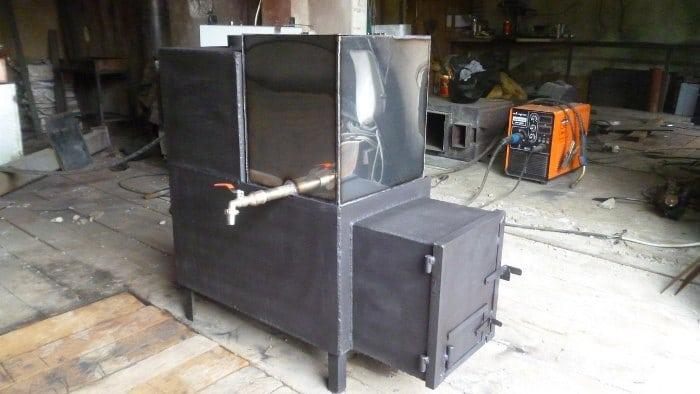
If you want to achieve an ideal result, you need to take the blue and add it to the solution at the rate of 1 tablespoon per bucket. It will eliminate the possibility of yellowing.
Lime mortar is made from the following components:
- lime – 1 kg;
- warm water – 1.5 l;
- drying oil – 1 tablespoon;
- blue – 20–25 g;
- salt – 1 tablespoon.
All components must be mixed and brought to a homogeneous mass. The highest quality whitewash is obtained from freshly slaked lime. Salt is necessary so that the whitewash becomes less dirty when it comes into contact with it. Salt is often replaced with milk, in an amount of 200–250 ml.
Lime whitewash is also applied in several layers. Unlike chalk, there is no need to wait for the previous layer to dry.
If the stove was previously painted with chalk, and you decide to use lime, then the previous whitewash should be removed. In the opposite situation, you need to do the same.
We invite you to familiarize yourself with Lacquer for steam rooms in baths
Painting sauna stoves is a decorative finish. The only practical benefit from such activities is the protection of metal surfaces from corrosion. Nevertheless, the aesthetic appearance of the stove is a rather significant characteristic that should not be neglected.
Characteristics
Metal stoves installed in bathhouses are constantly exposed to high temperatures and moisture. Modern stoves are made of stainless steel and structural steel. Even taking into account their advantages, metal surfaces must be covered with a protective layer. When choosing paint, you need to consider a number of requirements.
Heat resistance
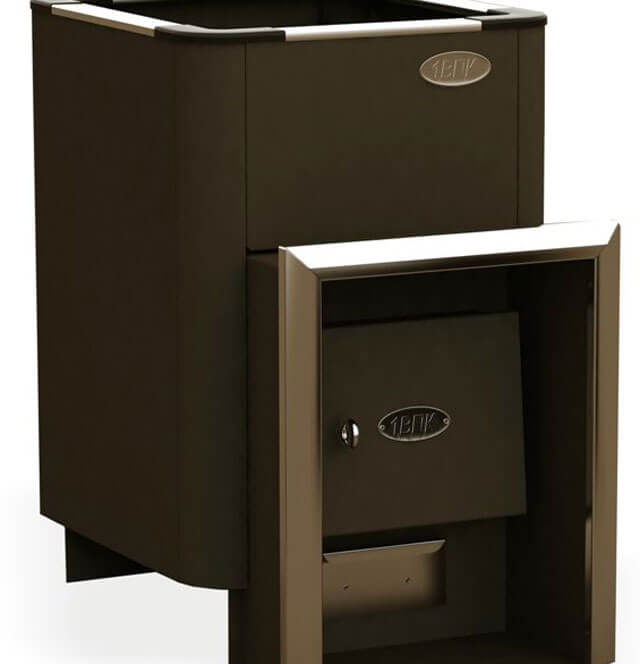
When choosing coatings for metal furnace equipment, it is necessary to pay special attention to the heat resistance indicator. Manufacturers indicate the maximum temperatures at which the enamel retains its properties.
Corrosion protection
Paints for a metal stove in a bathhouse should not allow moisture to pass through so that rust does not appear underneath. In addition to this, preference should be given to enamels that can withstand prolonged exposure to not only high but also low temperatures. The oven is not used constantly. In winter, many people do not heat their bathhouses, which causes the premises to freeze.
When choosing enamel, it is better to choose moisture-resistant compounds. The humidity level in bath rooms is constantly increased. If you choose a regular coloring composition, it will quickly become unusable due to prolonged exposure to moisture.
Safety
Many types of paint release toxic substances when heated strongly. To maintain health, you need to choose paints and varnishes with valid certificates.
Types of paints
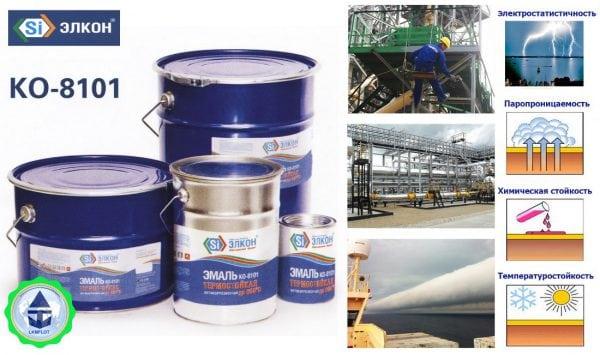
Advantages of paint KO-8101
- Paint KO-8101. The most affordable option, guaranteeing a service life of up to 15 years.
- Varnish KO-85 based on organosilicon. Shows excellent results in conditions of high humidity, is not afraid of rust, but the maximum temperature withstand is only 250 degrees, and this may not be enough.
- Enamel KO-8111. A high-quality composition that not only provides the necessary level of protection and meets environmental requirements, but also pleases with a wide range of shades.
- Heat-resistant paint "Certa". Quite popular in the CIS countries, it has the additional name OS-82-03T.
- Enamel KO-8222. A coating that has the best heat resistance, up to 800°C. Because of this advantageous property, it has a high price.
We invite you to familiarize yourself with Wooden crafts - 100 photos and video instructions on how to make a wooden craft with your own hands
In addition to painting the sauna stove, you need to take care of the hot water tank, special attention should be paid to treating it from the inside. There are several “old-fashioned” methods for this:
- Application of aluminum powder provides not only protection against rust, but also environmental safety.
- A solution of lime and cement in equal proportions. The water tank is coated inside with this mixture and dried.
- Treatment with red lead, which can be easily purchased in stores.
A number of modern means have been developed with which you can forget about the problem of rust forever:
- Anti-corrosion composition TsVES No. 2, containing zinc powder and ethyl silicate.
- The already mentioned heat-resistant “Certa”. The service life of the coating in a bathhouse is 7 years or more.
- Zinc-containing enamel "Ekotsin". Additionally, it protects against mechanical damage, which is a significant plus: the walls of the tank will not be scratched when you are trying to get rid of scale.
- Enamel KO-422. Treatment with this composition is called “cold galvanizing”.
Brief conclusions
I will answer a possible question - is it possible to paint a stove in a bath with oil, alkyd, vinyl, latex, acrylic, dispersion and other paints. I answer - it is possible. Just bake, don’t heat it later...
Tikkurila - heat-resistant paint
There is another option - experiment. For example, a friend decided to use paint for car mufflers, someone is trying something based on liquid glass, and so on. There are many different forums. If you do not want to paint an iron stove, you can do bluing. We associate this word with firearms. A good low budget option. How long will it last? Don't know. But good heat-resistant enamel is promised by manufacturers to last for at least 15 years.
We invite you to familiarize yourself with Making a foundation on water with your own hands ⋆ Build boldly!
Regarding chalk or lime color. There is one "impressive" drawback. It is difficult to achieve monotony. Streaks may be visible on the surface. Well, the durability of both options is approximately the same.
I hope the article was useful to you. If yes, then subscribe to the blog and recommend it to your good friends through social networks.
Anecdote: “My husband comes in the morning covered in lipstick, powder, and red hair.
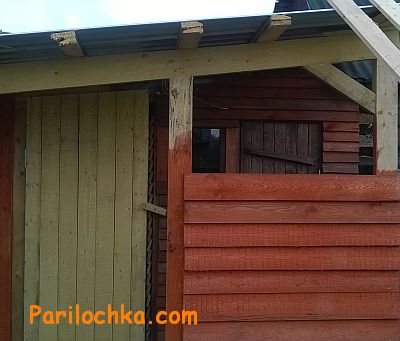
Wife: - Where have you been?
“You won’t believe it, my dear, I fought with a clown all night.”
Good luck and good painting of your sauna stove!
Wisdom Quote: Pleasure should be the reward for work.
Heat-resistant paints and enamels for baths and saunas
The choice of coatings for metal stoves is not very large. Only varnishes, enamels and paints based on polyurethane or silicone have high heat resistance and other necessary properties.
- Compositions based on polyurethane resins can withstand a maximum temperature of no more than 600 degrees, and with strong heating they change color unpredictably.
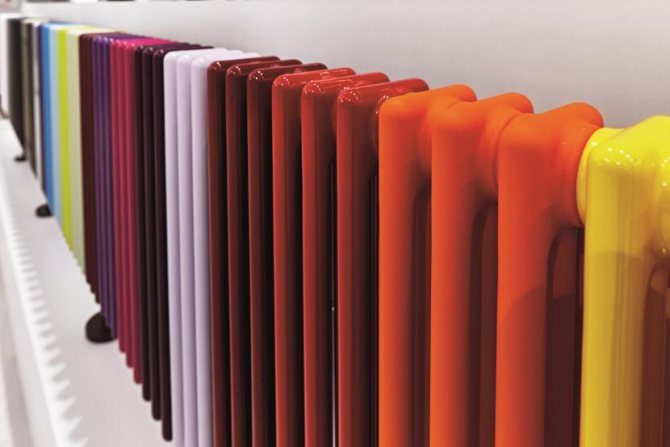
It is better to use such enamels to paint the surfaces of heating radiators that are not very hot Source lux-term.ru
- Silicone enamels, made without the use of toxic components and withstanding higher temperatures, are more reliable and durable.
See also: Catalog of companies that specialize in paints and varnishes
What to consider when purchasing
The characteristics of heat-resistant paint of different colors, even of the same brand and the same manufacturer, may differ. The base is the same, but the pigments used to impart color are different. They affect the properties of the compositions, and primarily their covering power and resistance to high temperatures. Therefore, before painting an iron stove in a bathhouse, so that it does not rust and remains in working condition for a long time, find out to what maximum temperature it heats up.
The most heat-resistant enamels are gray and silver. They add aluminum powder, which has a scaly structure and protects metals well from corrosion.
They are followed by compositions in black and all shades of brown, red, and green.
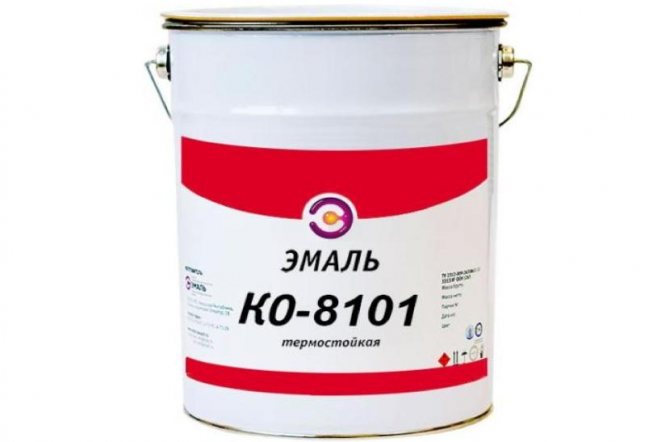
The heat resistance of paint depends on its color Source pk25.ru
The best brands
When choosing what to paint a metal stove in a bathhouse with, you can consider products from both foreign and domestic manufacturers. Moreover, our enamels are in no way inferior to imported ones in terms of heat resistance, hiding power, durability and durability. But these brands are deservedly considered leaders:
- Certa;
- Elcon;
- Kudo;
- Dali.
In addition to heat-resistant enamels, Cetra also offers patination compounds with the same properties, which can be used to decorate stoves and fireplaces, giving them an exclusive look.
Painting inside
Let's briefly go through all the issues related to interior painting. First, we will touch on issues related to surfaces made of different materials, then we will move on to the specifics of the premises. You will find details here in the article about painting the inside of a bathhouse.
Types of surfaces
Depending on the material and location of the surface, the requirements for coating change.
We've talked a lot about the differences and specifics of exterior painting here.
Therefore, here we will simply say that exterior paints and varnishes are becoming more powerful in properties - increased adhesion, increased resistance to adverse environmental factors, but this can be achieved at the expense of increased toxicity. That outdoors is not as critical as indoors.
Material
Now let's briefly go over the specifics of protecting materials such as wood, stone, brick and concrete.
The traditional method of dyeing is whitewashing
Elevated temperatures, high humidity, frequent heating and cooling cycles cause rusting not only of the sauna stove, but also of other metal structures located in the steam room.
This primarily concerns the tank intended for hot water. It needs to be painted not only from the outside, but also from the inside, since the water in it will cause corrosion. Painting the tank is carried out according to the same rules listed above. The only difference is that it needs to be coated with paint and varnish at the manufacturing stage. Once it is installed, such work will not be possible.
In addition to the tank, it would not be superfluous to paint the heat exchange system and the chimney pipe, which rusts quite quickly. It is better to paint boilers and other metal surfaces that the steam room is rich in at the same time. When answering the question of how to paint the tank and other metal surfaces of the bathhouse, the already mentioned paints and varnishes should be mentioned.
In addition to other advantages of painting stoves, tanks and other structures, it is also necessary to highlight the fact that cracks can appear on hot metal (especially cast iron) when it comes into contact with water. Thus, the painted stove can be safely used in a room with high humidity.
Whitewashing is one of the ancient methods of finishing a stove. The main advantage of this method is its low cost. Whitewashing materials, chalk or lime, are inexpensive and can be purchased at any hardware store. The whitewashing method is used in cases where it is necessary to refresh the appearance of an old stove or when the natural color of the brick does not fit into the existing interior.
Pros of whitewashing:
- requires minimal expenses;
- easy to implement;
- hides defects well;
- contains lime, which kills fungus.
Minuses:
- does not form a durable coating;
- leaves white marks on hands and clothes during use;
- gets dirty quickly;
- afraid of water and spoils from wet cleaning;
- requires regular updating.
There are several options for whitewashing. The most popular of them are chalk and lime. These methods have firmly taken root since the times when every home had a Russian stove. They tried to time the whitewashing of the stove to coincide with a wedding or holiday, since a freshly whitewashed stove gave the whole house a fresh and elegant look.
Chalk mixture recipe:
- powdered chalk – 3 kg;
- wood glue – 100 g;
- laundry soap – 50 g;
- water – 4 l;
- blue.
To prepare it, first dissolve wood glue and grated laundry soap in water, and then mix the liquid with chalk sifted through a sieve. Blue diluted in a small amount of water is added to the finished mixture. You need to tint the entire solution at the same time, because if you do it in parts, it is very difficult to achieve complete identical shade in different portions.
With lime:
- slaked lime – 5 kg;
- laundry soap – 100 g;
- salt – 50 g;
- PVA or wood glue – 50 g;
- water – 8 l;
- blue – from 10 to 30 g.
Since both mixtures contain soap, pre-priming is not necessary. Whitewash can be applied in three ways:
- wide brush with natural bristles;
- roller;
- sprayer.
Blueing
Burnishing is a chemical treatment of metal surfaces. Performed in order to increase the protection of metal from rust formation. Technique:
- Use a brush or sandpaper to clean metal surfaces until shiny.
- Mix 150 grams of phosphoric acid, 4 grams of butyl alcohol in 1 liter of water. Wipe the metal with the resulting solution so that the oxides disappear.
- Wash off any remaining acid with soapy water.
- Warm up the oven equipment to 150 degrees.
- Apply an even layer of sodium hydroxide.
All you have to do is wait until the protective layer dries to continue using the oven equipment.
Due to the growing popularity of metal sauna stoves, buyers are increasingly interested in whether the metal needs to be coated with a layer of paint. This operation is considered mandatory because it increases the protection of the material from rust formation.
Methods of coating, what is possible
So, you have cleaned and degreased it, and before that you have decided on the application method - with a brush, spray gun, roller or spray can . In principle, anything is suitable, choose what is more convenient for you. Perhaps it will be more convenient to spray paint some parts, while in others it is better to paint with a brush or roller.
As for the number of layers , it’s better for you to decide on the area; it depends on the chosen paint and how satisfied you are with the type of coating.
“ZERTA” promises an average thickness of one layer of 50 microns , despite the fact that at operating temperatures above 400 degrees, the coating thickness should be 28-32 microns .
Watch the video - there is nothing supernatural when painting with thermal paint:
And one more video - a man took the first paint he came across with a limit of 700 degrees and was pleased with the result:
Finally, let’s name the most famous manufacturers of heat-resistant paints that can be used to paint an iron stove in a bathhouse:
First, the paints you need contain composite materials and silicates.
Secondly, their range is in the range of 650-1000 degrees.
The most famous manufacturer of heat-resistant paints is probably CERTA. It is from this company that it is easiest to find enamels that can withstand the most extreme temperatures.
Another company from which we managed to find enamel with a limit of 1000 degrees is Elkon. Also a well-known manufacturer, by the way.
The Finns in this regard are somehow limited to lower limits, believing that the stove cannot heat up above red heat, but red heat itself is from 550 to 900 degrees ! Somehow this is at odds with the numbers on the label. Moreover, it is difficult to distinguish shades by eye, and this is hundreds of degrees of difference!
That is, it is clear that paint with a limit of 400 degrees is not the topic :). Therefore, we find it difficult to name Finnish enamel that, according to our standards, is suitable for a stove. It is better to take paint with a temperature reserve than to repaint it. But there is a guarantee of almost 20 years!
*** In fact, the options for painting an iron or cast iron stove in a bathhouse are a special case of painting. You may be interested in materials about how to paint the floors or walls of a bathhouse, what paints are used inside and outside, as well as a detailed overview of all the paints that can be used in bathhouses and saunas.
We are interested in your opinion - tell us more about your experience in finishing a bath in the comments.
To paint an iron stove in a bathhouse, you need to choose the right composition and follow the technology. The paint must be such that the coating can withstand temperature changes and high humidity characteristic of the room.
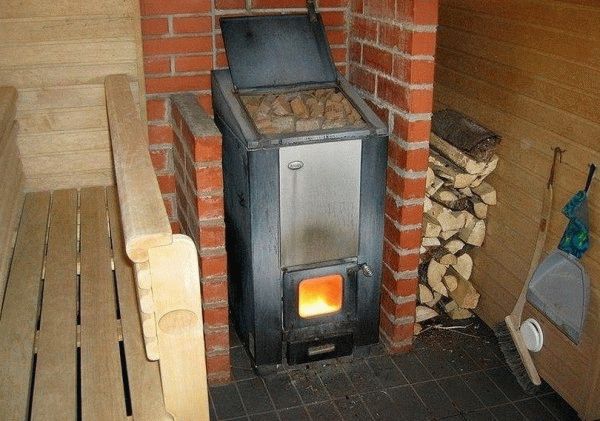
Design
We haven’t touched on this topic before, but why not really think with you about what color to paint the bathhouse and what design options there are in general?
We have paints and varnishes at our disposal. The bathhouse itself is either made of wood, or lined with wood, or brick, or plastered. Perhaps it is finished with stone, for example, on the foundation.
In general, it would be desirable to maintain at least some kind of stylistic unity - at least within the bathhouse itself, and at maximum - in all buildings. That is, if you decorated the house traditionally and in natural wood colors, then painting the outside of the bathhouse pink will look... foreign. But if all the buildings on the site are bright in color, then the bathhouse should be made no less bright.
Now about the styles. We have already said once in other articles that the bathhouse has three conventional styles: tradition, high-tech and “modern” (the latter means the use of modern materials without particularly advanced design ideas).
If you choose “tradition,” then you either have timber, a log house, or lining - paint in shades from yellow through orange and reddish shades to dark brown, better with varnish than paint, so that the texture of the wood is visible.
It’s hard to believe in real “high-tech” in a summer cottage. And if it is implemented, it will be according to a design project, where all the colors will be painted.
There is only one option left - the same “conditionally modern” style, which does not have its own face. Try to “revive” it by using brighter colors. And regarding the combination of colors, we advise you to search the Internet for pictures with the phrase “color schemes” - usually this is a photograph from which several colors have been extracted (stripes under it), forming a harmonious combination. It's easier than learning color theory.
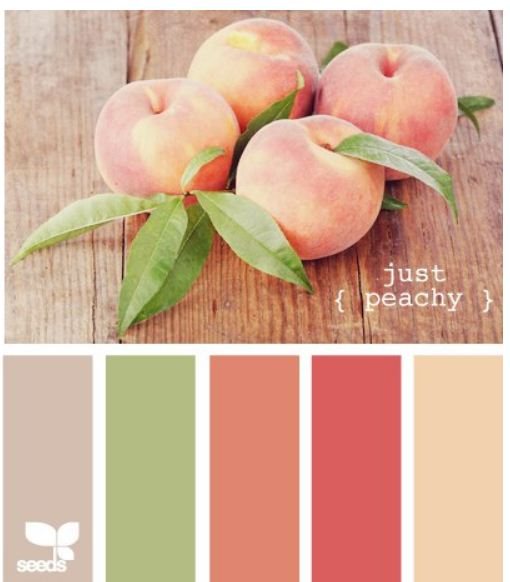
Example of color gamut extraction
How to paint a brick oven
The main task of paint is to protect the surface from rust. No matter how high-quality the material from which the stove in the bathhouse was made, the consequences of negative influences can appear over time. The hot water tank is most at risk of rust, and due to the fact that it forms from the inside, it is quite difficult to avoid it.
The second reason why a sauna stove needs to be painted is the aesthetic component. An object made entirely of metal is difficult to fit harmoniously into the overall picture of the room. Some finished products are sold already painted, otherwise you will need to do it yourself.
It is possible to paint a brick oven; moreover, it is advisable to do this before the start of operation. This is done not only for aesthetic reasons. Untreated brick has a porous structure and, like a sponge, absorbs grease, soot and other contaminants. The resulting stains cannot be washed off without damaging the brick.
Paint or varnish applied to brickwork seals pores and microcracks. After the paint mixture has completely dried, a dense layer is formed that protects the brick from dampness and dirt, and also makes it easier to maintain the stove. Some modern paints contain additional components, for example, antifungal or anti-corrosion.
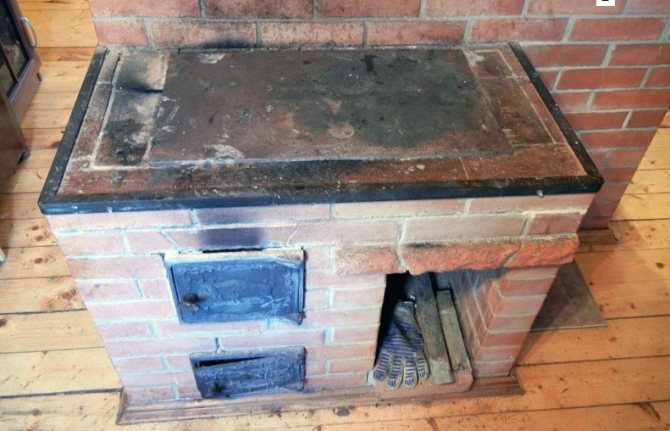
Old brick oven
- condition of the stove (new, old);
- operating mode (constant, periodic);
- likelihood of contact with water (living premises, bathhouse);
- surrounding interior (style, color scheme).
For example, it is more advisable to emphasize the beauty of new brickwork without a single flaw using a transparent coating (drying oil, varnish). An old stove that has defects or has been damaged by dampness can be painted with paint of the desired color.
Different types of paint
To paint a stove in a house or country house, you need to use a special type of paint. They are called heat-resistant because they retain their structure even under high heat. Heat-resistant paints are divided into several groups:
- low heat resistance (80–100°C);
- medium heat resistance (120–200°C);
- high heat resistance (400–650°C).
Only paints with high heat resistance are suitable for coating ovens. Stove masters recommend combining different types of paints when painting different elements of the stove. This allows you to get high-quality results without unnecessary expenses.
The main part of the stove, made of brick, can be painted with Ecoretta paint or Thermolux antifungal paint. For metal parts of the stove (doors, dampers), it is recommended to use paints of the Certa, Dali, and Celsit-500 brands. These materials, in addition to high heat resistance, have anti-corrosion properties.
Drying oil and varnish
Drying oil is suitable for those who want to preserve the original appearance and texture of brickwork. As a rule, new stoves that do not have defects are coated with drying oil. Drying oil is distributed with horizontal movements over the surface of each brick.
We suggest you read: Choosing paint for a children's room How to choose paint with your own hands How to choose paint for a nursery
Benefits of drying oil:
- has a natural composition;
- does not contain toxic substances;
- allows you to emphasize the pristine beauty of brickwork.
Flaws:
- limited heat resistance (stoves coated with drying oil can only be used for a few hours);
- does not protect masonry joints.
Popular types of oven varnishes today are heat-resistant silicone varnishes (KO-85, KO-815, Siltek-1). They provide reliable protection for bricks and seams, adhere well to the surface, and withstand prolonged heating and temperature changes. The disadvantages of this group of varnishes are the presence of acetone and other toxic substances in the composition, and a pungent odor at the time of application. However, completely dried varnish does not smell even when heated and is absolutely safe for the inhabitants of the house.
Apply the varnish to a clean, dry surface of brick and metal parts using a brush or spray in 2-3 layers with intermediate drying for 20 minutes. Drying time is 30 minutes. The varnish contains the flammable substance acetone, so it should not be used near an open flame.
Supporters of environmentally friendly materials can use the old recipe for stove varnish. The gloss mixture contains chicken egg whites, milk and brick chips crushed into powder. The surface of the brick is covered with a brush with the mixture in one layer and allowed to dry for 24 hours. The result is a beautiful matte terracotta finish. However, this method has a significant drawback: when heated, the stove begins to smell like baked milk.
Sequence of actions when painting:
- inspect the masonry, if there are cracks in the seams, remove the top layer (0.5–1 cm) and repair the defect with fresh mortar;
- wait the time necessary for the solution to dry completely;
- remove irregularities by sanding;
- Use a construction vacuum cleaner to remove any accumulated dust;
- remove dirt and traces of efflorescence using a wire brush and soap solution;
- rinse with clean water using a sponge for cleaning car windows;
- dry overnight;
- apply paint using a brush, roller or spray gun;
- dry for 24 hours;
- It is good to heat the oven to finally fix the paint.
Paint or varnish can be applied in one or several layers. When applying one layer, a “wet brick” effect occurs. The natural color becomes deeper, emphasizing the texture of the brickwork.
When painted in multiple layers, the stove looks varnished. The resulting protective film is thicker and easier to withstand wet cleaning. Any contamination from a stove painted using this method can be easily removed using water and soap.
The above is quite enough to decorate the stove in the house with your own hands. However, I advise you to watch the following video, which can be very useful if you have no experience in painting work.
Chalk or lime were used to process brick kilns. These are environmentally friendly compounds that do not emit toxic substances. But surfaces painted with them need regular care and renewal, since they are not durable and can become covered with many small cracks. Some experts recommend using oil-based compounds for treatment, but you need to understand that they take a long time to dry and emit an unpleasant odor.
Another way to protect a sauna stove from negative influences
Before painting a metal sauna stove, you need to choose a paint, and for this you need to take into account some important factors.
We invite you to find out which foundation is better: pile or monolithic
When choosing paint, you should take into account the fact that the surface to be painted will become very hot. Therefore, standard options will not work here. Ordinary paints will not stick to hot metal; they will peel off or burn.
Another point that you should pay attention to when choosing paint for an iron sauna stove: any type of metal expands when heated. Therefore, the material with the lowest value of this indicator is selected for the furnace. There is no metal with an expansion coefficient equal to zero. Accordingly, there is a high probability that the applied paint will crack.
You don’t have to think about how to paint an iron stove in a bathhouse, since not only paint can protect it. The method of metal bluing, which involves creating a chemical reaction, is widely used.
First the surface must be cleaned. To do this, use a 5% sulfuric acid solution, which should be applied with a brush. Then the laundry soap is diluted in water in a ratio of 50 g per 1 liter. This solution must be used to wash off the previously applied sulfuric acid. Next, the oven is heated to 150-180°C and treated with caustic soda diluted in water in a ratio of 50 ml per 1 liter. The composition should be applied only by spraying to avoid splashing.
Conclusion
In order for the stove to serve for a long time, it must be well treated, and for this you should make the right choice of what to paint the stove in the bathhouse with. The solution to this issue should be taken with full responsibility and there is no need to save money, because the stove is the main component of the bathhouse.
Advantages and disadvantages
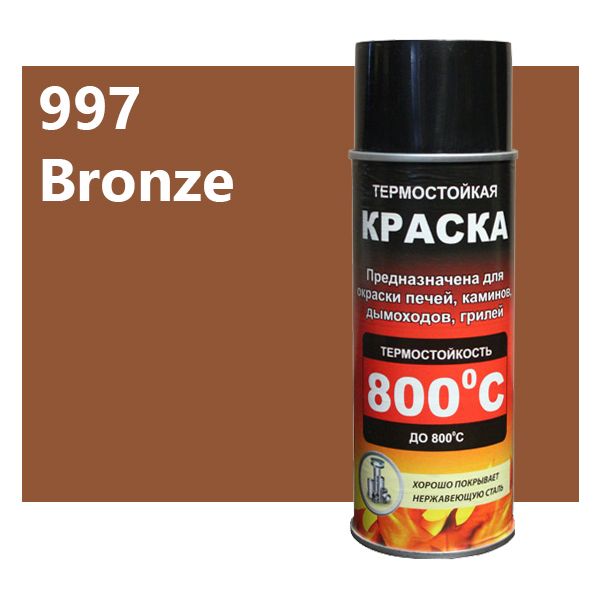
Although the cost of paints is high, this does not guarantee that the work will be done flawlessly and the painting will be at the highest level.
Like any composition, heat-resistant aerosol has its advantages and disadvantages.
Among the advantages we note:
- the metal composition in the can is completely ready for use, so no additional surface preparation is required;
- the spraying method allows the paint to penetrate into hard-to-reach places and ensure uniform painting;
- the painting process does not involve the use of additional tools (brushes, rollers) in addition to personal protective equipment (gloves, mask);
- high adhesion to metal surfaces;
- the heat-resistant mixture is resistant to sunlight, does not fade or fade;
- for the transportation of aerosol coatings, no special transport measures are required;
- aerosol heat-resistant mixtures have a wide range of products: acrylic, oil, epoxy;
- has a rich palette of colors, which provides an opportunity for creativity;
- since the paint is applied by spraying, the thickness and area of application can be adjusted, which allows you to paint any product in an original way;
- using the spray intensity, you can achieve a smooth transition from one layer to another;
- a can of used paint does not dry out for a long time, so it can be used several times in a row;
- thermal aerosol paint does not emit any foreign odors.
Disadvantages include:
- colors from different cans do not mix well with each other;
- working with spray paints requires some experience in application, because smudges may form;
- to create clear lines when painting, you will need a stencil;
- the consistency of the product in the can cannot be adjusted;
- When working in an open space, you should take into account weather conditions that can make working with paint difficult (rain, wind, sun).
Types and description of paints
For painting surfaces that are exposed to high temperatures, the following types of paints are used:
- heat resistant;
- heat resistant;
- fireproof;
- high temperature.
Heat-resistant oven paint is designed to withstand temperatures in excess of 800 °C. Maximum value 1000 °C. Such coatings are made on the basis of silicon and organics. They are used for coating the bodies of metal furnaces. The combustion chamber in them can heat up above 650 °C.
metal paint The combustion temperature of wood-based fuel for the same fireplaces is approximately 300 °C. And the recommended temperature limit for heat-resistant paints is 600 °C.
Fireproof paint for stoves can withstand exposure to open fire. It can withstand temperatures over 1000 °C. Usually it covers the internal surfaces of the combustion chambers. True, the cost of products coated with fire-resistant paints is much higher. Therefore they are mainly used in industry.
High-temperature coatings are intended for painting heating radiators, brickwork of stoves, and elements of internal combustion engines. Their use is justified if the operating surface temperature does not exceed 200 °C.
Heat-resistant varnishes are used to impart gloss and shine to the painted surface. They adhere normally to surfaces up to 300 °C. The brickwork of the fireplace, coated with heat-resistant varnish, becomes brighter, and there is no need to cover it with ceramic facing tiles.
Fire retardant paints can be found on sale. Their purpose, as the name suggests, is related to fire protection. But the purpose is to prevent the spread of fire. When heated to 200 °C, fire-retardant paint begins to swell, releasing substances that prevent the access of oxygen. This prevents the spread of fire and the occurrence of a fire.
Requirements for paints for iron sauna stoves
The choice of paint depends on what material was used to make the stove. There are a number of general requirements - for example, you can only take compounds that can withstand high temperatures. But if a metal stove is installed in the bathhouse, then the paint should be such as to protect the material from corrosion.
Blueing is a more effective protection than painting, but it takes a long time. The process is accelerated if the boiler is heated to 200°C, but this is not always possible, so coloring is a more affordable method.
When buying paint, it is important to remember that negative factors affect a sauna stove:
- high humidity;
- steam, which affects the condition of the outer surface;
- high temperatures inside;
- temperature changes outside.
Even taking into account the fact that it is not a cast iron stove that needs to be painted, but a surface made of high-quality stainless steel, not all mixtures are suitable for this. They have to:
- be resistant to temperature changes;
- provide a high level of corrosion protection;
- comply with environmental standards;
- have water-repellent properties.
Coloring instructions
Having learned how to paint the stove in the bathhouse, you can purchase paint and prepare the stove for painting.
Tools and materials
To do the work yourself you will need:
- paint, preferably in aerosol cans;
- if you use liquid paint in cans, you will need to purchase a roller and brush;
- sandpaper to remove a layer of rust;
- metal brush;
- when cleaning large areas, use a grinder;
- solvent for degreasing parts;
- for painting you can use a spray gun and a compressor, especially with large dimensions of the structure;
- rags;
- paper or old sheets to protect the surface of walls and floors when painting.
Having dealt with the question of how to paint an iron stove in a bathhouse and having prepared the materials necessary for the work, you can begin to carry out the preparatory work.
Surface preparation
To do this you will need to perform a number of simple works. But surface preparation must be approached with full responsibility; this determines how the paint will adhere to the metal and how long its layer will withstand high temperatures:
- Using a metal brush, we clean the stove from adhering dirt, soot and rust;
- Clean the finished surfaces with fine sandpaper. This work will make the surface smooth, remove minor scratches and irregularities;
- sweep and remove dust from the stove parts;
- Having generously moistened a rag with solvent, degrease all surfaces;
- If the stove has parts made of stainless steel or those that have undergone galvanic treatment, there is no need to paint them. Therefore, we will apply a layer of grease or other lubricant to the parts;
- cover the surface of the floor and walls next to the heater, paper or cloth.
Paint application algorithm
We know how to paint an iron stove in a bathhouse, the necessary preparatory operations have been completed, now you can move on to the main stage of work. This will not require much time and effort. All work is carried out in the following sequence;
- open and stir the paint well. If it is thick, it can be diluted with a solvent suitable for this enamel. Be sure to read the instructions and dilute the paint only with the specified mixtures. Otherwise, you'll just throw away a can of expensive paint;
- if a spray gun is used to apply the layer, the paint is diluted to a more liquid state, then poured into the spray gun through a painting sieve or the wife’s old tights;
- first apply a layer to all inconvenient places and edges of the oven and only then treat the surfaces, slightly overlapping the previous layer. When painting with a brush, the work is done in the same way;
- The paint is applied in 1 layer, so do not allow any gaps, painting all surfaces evenly.
Work is done. Now leave the oven until the enamel hardens completely. It is important to close all doors and windows to prevent dust from entering the room. For some paints you will need to light the oven; they only harden when warmed up. Therefore, carefully read the instructions and strictly follow these rules.
How often should I paint in the future?
The paint for an iron sauna stove will last for the period specified by the manufacturer. You need to pay attention to this characteristic when purchasing enamel.
In any case, if the stove is made of thin metal, it may fail before the paint coating of the surfaces. Paint is a short-lived coating, so every bathhouse owner should be prepared for repeated work to protect the stove.
Is it possible to achieve a durable protective layer on the surfaces of the heater? Yes, in this case, performing a simple galvanic method of protecting the metal will help.
